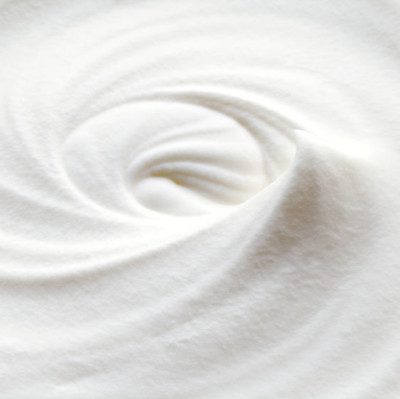Composition
Cream is a dairy product consisting of water, protein, lipids, carbohydrates (sugars, including lactose), vitamins, minerals, and other minor components. Various types of cream are distinguished by their butterfat content, processing method whether heat treated, whipped and so on. The fat content ranges from 18-55%.1
Most common additives to cream are:
- Emulsifiers
- Sweeteners
- Flavorings
- Stabilizers
- Preservatives
Some dairy companies add polysorbate to the formula to increase whipping and stability without the addition of stabilizers.
Commercial production
Cream is the fatty liquid that forms a layer on the top of milk prior to homogenization. A process of continuous centrifugation separates cream. The centrifugal force causes natural separation of the fat globules from the milk serum.1 The separated cream is then homogenized and pasteurized or ultra-pasteurized.
When pasteurized, better flavor can develop and the cream whips up with greater fluff. Ultra-pasteurized versions offer an extended shelf life. It has a cooked flavor and is more sensitive to whipping, therefore it is not ideal for recipes that require peaks or frothing.
Function
Cream is commonly used in baked goods to:2
- Increase moisture absorption
- Provide lactose which gives browning reaction upon baking
- Tenderize
- Serve as a buffering aid
- Increase protein content and nutritional value
- Enhance its foaming ability in cakes and frozen desserts
Applications
Following are some applications of cream in the food industry:
- As an ingredient in many foods such as ice creams, cakes, sauces, puddings, etc.
- As a topping in many cakes, pancakes, milkshakes, hot chocolate, fruits, etc.
- It also finds applications in hot beverages such as tea, coffee, etc.
- In pastries it is used in cream fillings, custards, and frostings
FDA regulation
FDA states that cream must contain at least 18% milkfat, and it should be pasteurized to remove any harmful pathogens. The FDA provides specific guidelines for milk and cream, including pasteurization conditions under CFR § 131.3. It mandates that ultra-pasteurized cream is heated at or above 280°F (138 °C) for at least two seconds. The following table gives an account of % fat, processing steps, contents, and the FDA regulation of different types of cream.
| Name | % Fat | Process | Contains | FDA regulation |
| Dry Cream | 40-75 | Pasteurized | Emulsifiers, Stabilizers, Anticaking agents, Antioxidants, Nutritive carbohydrate sweeteners, Flavoring | § 131.149 |
| Heavy CreamHeavy Whipping Cream | 36 | Pasteurized, Ultra-pasteurized, Homogenized | Emulsifiers, Stabilizers, Sweeteners, or Flavoring | § 131.150 |
| Light Cream, Coffee Cream, Table Cream | 18-30 | Pasteurized, Ultra-pasteurized, Homogenized | Emulsifiers, Stabilizers, Sweeteners, or Flavoring | § 131.155 |
| Light Whipping Cream, Whipping Cream | 30-36 | Pasteurized, Ultra-pasteurized, Homogenized | Emulsifiers, Stabilizers, Sweeteners, or Flavoring | § 131.157 |
| Half and Half | 10.5-18 | Pasteurized, Ultra-pasteurized, Homogenized | Emulsifiers, Stabilizers, Sweeteners, or Flavoring | § 131.180 |
References
- Hoffman, W. “CREAM | Manufacture”. Encyclopedia of Dairy Sciences, 2nd edition, Academic Press, 2011, pp 912-919
- Jonas, J. J. “Utilization of dairy ingredients in other foods”. Journal of Milk and Food Technology. 36(6), 1973, pp 323-332.

